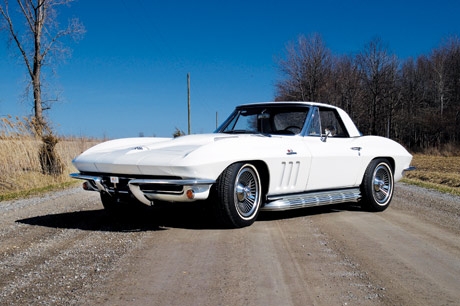When the new-for-1963 Sting Ray was introduced, it is unlikely that its creators understood the impact it would make on the automotive world. Long considered a modern classic, the Sting Ray was an unqualified success, outselling the 1962 models by 48%. Meanwhile, a second shift was added at the St. Louis assembly plant to meet the growing demand.
While the Sting Ray was continuously improved, the big news for 1965 was the mid-year release of the Mk IV 396 V8 engine, derived from the 427-ci “mystery motor” that was banned from NASCAR. Producing 425 brake horsepower, the 396 option included a mandatory transistorized ignition and 4-speed transmission, while air conditioning was not available. Finally, all Corvettes received four-wheel disc brakes with four-piston calipers and ventilated rotors.
This remarkable, unrestored example is one of a mere 2,157 1965 Corvettes equipped with the legendary 396-ci V8. The odometer shows just over 41,000 original miles, and the car is offered complete with both a white hard top and a black soft top. The Corvette also features a set of knockoff finned aluminum wheels, an optional AM/FM radio, power-operated antenna, and a desirable teak-rimmed, three-spoke steering wheel.
While not detailed and showing some evidence of road use, the engine, underhood area, and undercarriage are well-maintained, period-correct, and tidy in their presentation.
SCM Analysis
Detailing
| Vehicle: | 1965 396/425 Convertible |
| Years Produced: | 1965 |
| Number Produced: | 23,562 (8,186 coupes, 15,376 roadsters) |
| Original List Price: | $4,321 |
| SCM Valuation: | $70,000–$125,000 |
| Tune Up Cost: | $150 |
| Distributor Caps: | $25 |
| Chassis Number Location: | Plate under glovebox |
| Engine Number Location: | Pad forward of cylinder head on passenger side |
| Club Info: | National Corvette Restorers Society, 6291 Day Road Cincinnati, OH 45252-1334 |
| Website: | www.ncrs.org |
| Alternatives: | 1962–67 Jaguar XKE SI convertible 1965–67 Austin-Healey 3000 BJ8 1964–67 Pontiac GTO convertible |
| Investment Grade: | B |
This L78 Corvette sold for $101,750 at RM’s Sports & Classics auction in Monterey, California, on August 15, 2008.
The Corvette Sting Ray was Bill Mitchell’s love child. Its genesis was his privately funded Stingray Special, which was a bootleg backdoor project thanks to the AMA performance ban. It was developed without formal approval from General Motors but with Zora Arkus-Duntov’s involvement in developing the chassis and drivetrain. The result, the Stingray Special, was driven by Dr. Dick Thompson—the “Flying Dentist”—in SCCA C-Modified competition, and the car won the 1959 and 1960 championships. The race car could not be identified as a Corvette due to a rule buried in the fine print, but many predicted it was the next generation Corvette.
When the Sting Ray was introduced in 1963, it was, in nearly every respect, a new Corvette. The styling, particularly the humped fenders, was heavily influenced by Mitchell’s Stingray, and the futuristic fastback was the first production Corvette coupe. The quad headlights were retained but were now concealed in pivoting sections that fit flush with the body. The Sting Ray was a smash, and 21,513 of them left dealer showrooms, almost 7,000 more than the record-setting 1962 model year.
Based on the Daytona “mystery” engine
The 1965 Corvette retained the same basic styling and was easily recognized by the crisp, sharp-edged shape of the 1963, but it had three fully functional vertical fender louvers and a narrow horizontal grille that was blacked out. In mid-March 1965, the big-block Mk IV 396 was introduced as a $292.70 option. It was based on the “mystery” 427 racing engine that showed up for the 1963 Daytona 500. The 396 “Turbo-Jet” was easily recognized by the special hood required for the big-block. It offered 0–60 mph in 5.7 seconds, 0–100 mph in 13.4 seconds, and could turn the quarter mile with a top speed of 104 mph.
Gather a group of Corvette guys and gals at a local watering hole, pose the question as to which is the “best” Corvette, and the resulting discussion will last well past closing time. But the 1965 Sting Ray with the Mk IV 396-ci, 425-hp engine will be on most everyone’s list because of its crisp styling, four-wheel independent suspension, disc brakes, ground-pounding performance, and the relative rarity of its 1965-only availability, a prelude to the mighty 427 that followed.
With that said, why did the example offered here not attract more attention and sell in the anticipated $125,000–$135,000 range? The car was stated to be highly original, and upon inspection there was evidence to support that claim. With a touch over 41,000 miles on the odo, the condition of the interior was commensurate with the mileage. That was not the case under the hood, as a clean rag had not made an appearance in some time. The spark plug wires were unusual and the plugs lacked the cadmium heat barrels. Also, the distinct paint demarcation between the orange cylinder heads and the totally unpainted exhaust were atypical of an unrestored car.
Sidepipes and knockoffs would have been rare indeed
A car that came with factory sidepipes and knockoff wheels would have been rare indeed in 1965, so odds lean heavily in favor of reproduction parts in both cases.
The bigger question was documentation of the Mk IV engine. Corvette owners are quick to claim “numbers matching,” but that was not heard here. Also, if you have a rare, highly sought-after Corvette you are claiming is original and unrestored, would not a Bloomington Gold certificate add to the value?
Given the end result of the bidding, what seems to have made the most impression on the potential buyers is what was NOT stated. If the numbers do line up, somebody made a hell of a buy
